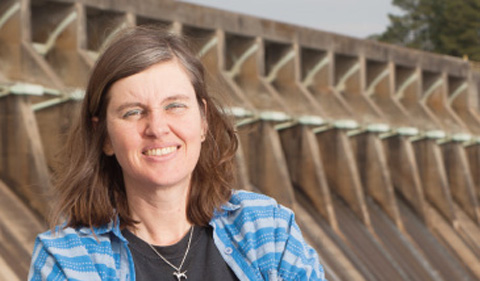
Dr. Melanie DeVore
The Environmental & Plant Biology Colloquium Series presents Dr. Melanie DeVore on “Building Temperate Forests in Deep Time: Clues from the Eocene Okanagan Highland Floras” on Friday, Feb. 17, at 11:50 a.m. in Porter Hall 104.
DeVore is a professor in the Department of Biological and Environmental Sciences at Georgia College.
Abstract: The latest early Eocene Republic locality of Washington, and other Okanogan Highlands sites in British Columbia, provide a record of high elevation floras with temperate elements that is contemporaneous with tropical coastal forests of the Eocene thermal maximum. These floras have been a subject of a research collaboration between Kathleen Pigg’s research group at Arizona State University and our program at Georgia College. What are the processes that build a temperate forest? What is the connection between high elevations and the origin of temperate floras? How can we use fossil floras to explore the drivers of evolutionary mechanisms within lineages of temperate families of flowering plants?
Understanding the dispersal and radiation of plants into new habitats, whether they are high altitude, or high latitude entails recognizing certain anatomical and morphological features in the fossil record. One pattern we documented was the apparent heteromorphic growth of Zizyphoides Seward and Conway leaves at the Republic, WA, site, as evidenced by their long-shoot and short-shoot morphological differences (DeVore and Pigg 2013). Fossil leaves from this extinct genus appear to compare closely to extant dimorphic leaves such as those known to occur in Populus L. (Salicaceae, Eckenwalder 1980), and the Asian genus Cercidiphyllum Sieb & Zucc. (Cercidiphyllaceae, Krassilov 2010). The presence of long shoot/short shoot branching is linked with preformed leaves that overwinter in the buds on short shoots and become immediately available for photosynthesis upon bud break, while long shoot leaves later fill out the canopy. This type of heterophylly maximizes the opportunity for photosynthesis early in the spring in plants with certain types of dormancy.
Hybridization is another key mechanism for increased diversification and speciation among modern plants and is especially important in certain families such as Rosaceae and Anacardiaceae. This mechanism occurs commonly in areas of ecological disturbance, distribution, and migration. Resulting hybrid individuals have characteristic intermediate or mosaic patterns that combine those of the two parents in morphologically distinct and identifiable ways. The Republic flora includes relatives of modern taxa that are known to hybridize and produce characteristic patterns of leaf morphology and venation (Rosaceae; Anacardiaceae). We have found fossil leaves that are comparable to those indicative of hybridization in the modern relatives and provide, in the future, a potential means of statistically documenting hybridization.
What would be the closest modern analogue to Okanagan Highland floras? Currently we are beginning to look at highland floras in both the New and Old Worlds as a model. First, floras of both continents have suites of populations actively hybridizing within high elevation vegetation zones. Secondly, the presence of Prunus africanus at high altitudes in the Virunga Mountains, suggests that it is a relictual element of a taxon known to be more widely distributed during the Paleogene. Finally, both the Northern Andes and Virungas host endemic, woody rosaceous taxa with compound leaves in montane ecosystems. In both the case of Hagenia (Africa) and Polylepis (Andes) these arborescent taxa originate from herbaceous ancestors. We see a similar pattern of highly dissected to compound leaves attributed to Rosaceae such as the extinct genus Stonebergia in the Eocene of western North America. Collectively, these studies are providing initial hypotheses based on the fossil record to use to address questions regarding the building of temperate forests in deep time.



















One Comment